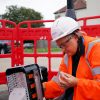Broadway Locals Secure Judicial Review of Broadband Poles Rollout UPDATE

The Lifford Gardens and The Sands residents association, which represents part of Broadway (village) in Worcestershire (England), has been granted a Judicial Review (JR) in the High Court that may allow them to challenge the local council’s decision to allow deployment of a new gigabit-capable broadband network using wood poles.
Network operators often deploy 9-12 metre high wood poles to help run their overhead cables, which are a very common sight across the UK (millions have been built). Such poles are quick and cost-effective to build, can be deployed into areas where there may be no space or access deal to safely put new underground cables, are less disruptive (avoiding the noise, traffic restrictions and damage to pavements of trenching) and can be built under Permitted Development (PD) rights with only minimal prior notice.
However, not everybody is a fan and a growing number of people in areas where poles are being deployed have often voiced objections, particularly when they’ve been rolled out into an area that hasn’t previously had them before. Residents typically find the new erections ugly, obstructive, and often complain about the lack of effective prior consultation.
Advertisement
The issue recently came to somewhat of a head after the Government stepped in and called on network operators to “limit installation of telegraph poles” (here and here), albeit largely by reiterating the rules that operators already follow.
The Government has also called on Ofcom to provide guidance to local planning authorities on how to raise complaints, as well as asking them for support to tackle the challenge. But the industry regulator has warned that their powers are limited (here).
Broadway’s Sitation
The situation in the village of Broadway follows a similar trend to the one mentioned above, although in this case one of the local residents associations has decided to take a more proactive legal approach to challenging the deployment. Both Gigaclear and FullFibre Ltd are known to be deploying FTTP broadband networks in this area (Openreach also has a little FTTP), with each using a variable mix of overhead (poles) and underground (ducts) infrastructure in different areas.
The case itself largely focuses upon FullFibre’s build. However, rather than specifically going after the network operator (FullFibre is merely referenced as an “interested party“), the residents have instead been trying to secure a Judicial Review (JR) of the Wychavon District Council‘s (WDC) decision to allow such work to take place.
Advertisement
The case, which was heard in the High Court (Administrative / Planning Court), appears to partly reflect the fact that there are usually extra considerations for Areas of Outstanding Natural Beauty (AOBN) like those that exist in Broadway:
Extract from the Cabinet and Pole Siting Code of Practice
In National Parks and Areas of Outstanding Natural beauty, the Code Operator should discuss new pole locations with the relevant National Park Authority or AONB Partnership at an early stage to identify opportunities to minimise any adverse landscape impact.
The case argued that the local authority may have failed to properly interpret or take account of such key considerations, which affect the siting and appearance of the development (i.e. did the council take enough action to ensure the visual impact would indeed be minimised, so far as practicable? – this is needed for the work to be considered Permitted Development).
Some of this also touches on the question of whether an underground deployment would have been viable as an alternative to poles, which is always a tricky one for cost-sensitive network operators to balance. But other parts suggest that the local authority might have been a little too close to FullFibre Ltd.
Extract from the Residents Crowdjustice Page:
“When the cable provider first indicated that they intended to pole in Broadway, the residents, the Parish Council and the AONB Planning Officer all registered their objections to Wychavon D.C. We were all ignored as the council chose to do absolutely nothing to prevent the telegraph poles from being erected.
Residents were extremely concerned that Wychavon District Council had appointed a person who was not in planning to oversee the planning directorship dealing with the proposed installation of poles and broadband in our community, when this individual had a pre-existing relationship with the personnel of the telecoms operator (Full Fibre Ltd).
Following a freedom of information request, emails obtained between the two created a perception of bias in the minds of residents that the person appointed by the Council was in favour of the roll out of poles and overhead infrastructure.”
The good news for the residents association is that they’ve now won the ability to seek a JR, with the judge agreeing that two of the three grounds merited investigation. The third ground was only rejected as it was considered to be a duplicate of the first ground.
Advertisement
The Honourable Justice Eyre also agreed that “the tone of Mr Edward’s [of WDC] emails to the representatives of the Interested Party [Full Fibre Ltd] is suggestive that he regarded the exercise a joint venture in which the Defendant [WDC] and the Interested Party [Full Fibre Ltd] were engaged together in overcoming resistance to the installation of cables.”
David Harrison, Broadway Resident, told ISPreview:
“Living in an Area of Outstanding Natural Beauty (AONB), in which we are not even allowed to erect fences or walls in our front gardens, we were amazed and disappointed when Wychavon D.C. said they could do nothing to prevent Full Fibre Heroes Ltd erecting twenty two 11 metre poles to facilitate new Ultrafast Broadband. They said “their hands were tied” as new legislation gave communication providers Permitted Development Rights and they made no effort to prevent our visual amenity being spoilt. We know they could have issued an Article 4 direction that would have then forced Full Fibre to apply for formal Planning Permission.
In March 2024 the Minister for Media & Data, Julia Lopez M.P. confirmed that even where Permitted Development Rights exist, it doesn’t mean the council have no say in the matter. We cannot understand why Wychavon D.C. made absolutely no effort to protect our village and our visual amenity. We hope that our Judicial Review will clarify the position within AONBs & Conservation Areas that were previously protected by law.”
Just to be clear. A JR is a special type of court proceeding in which a judge reviews the lawfulness of a decision or action made by a public body. Such reviews are designed more to investigate how a decision has been made rather than whether or not the outcome of that decision was the right one, although if successful the council might be forced into making amendments, which could set a precedent elsewhere too.
The residents association is currently in the process of using the Crowdjustice website to help them raise enough funding to support the JR. The JR case itself, assuming it does proceed (funding allowing), is expected to take place sometime later this year, possibly toward the end of autumn or later. So at present the association has only won the right to pursue a JR, which is somewhat of a test case.
The JR itself could just as easily decide that the local authority did everything correctly. However, whatever the outcome, network operators, councillors and residents should at least be able to gain greater legal clarity around the issue and this is something that would be useful for everybody to have.
The risk for locals in that, if they lose, they will be liable for the council’s costs and vice versa. The residents association is currently attempting to raise £2,000, but they will then seek to push this up to around £20,000 in order to properly fund the case.
However, the risk for the roll-out of gigabit-capable broadband is that operators could end up having to jump through extra hoops, which might slow their deployments and increase their costs. Some people would clearly celebrate this. But it could also make some builds just that bit too expensive to proceed, which seems likely to disproportionately disadvantage those in some of the most poorly served areas (i.e. those that are often among the most expensive to tackle).
We did reach out to the WDC for a comment last week, although organisations rarely comment when the query involves an ongoing legal case. For the same reason, FullFibre Ltd declined to comment.
UPDATE 9:46am
We’ve had a comment from the local authority.
Meesha Patel, Director of Legal and Governance for Wychavon District Council, told ISPreview:
“We’re clear that Permitted Development Rights mean we have no powers to prevent the installation of poles under 15m, force communication infrastructure to be installed underground or to have poles removed once installed. While the original application for a Judicial Review was rejected, we respect the fact that on appeal the court felt a review of the decision-making process was justified and we will present our case accordingly once a date for a hearing has been set.”
Mark is a professional technology writer, IT consultant and computer engineer from Dorset (England), he also founded ISPreview in 1999 and enjoys analysing the latest telecoms and broadband developments. Find me on X (Twitter), Mastodon, Facebook, BlueSky, Threads.net and Linkedin.
« 5G Has Stopped Working for Some Lyca Mobile UK Customers























































“the risk for the roll-out of gigabit-capable broadband is that operators could end up having to jump through extra hoops”
It would only apply to areas which have already been designated as National Parks or AONB, in which case those additional hoops should already be in place.
People who live in these areas already accept limitations to what they can do – for example restrictions on satellite dishes or solar panels.
That is the problem , because of permitted development rights , the hoops have been removed in essence. The only areas that are protected with some planning and overseeing of works are scheduled monument areas , and areas of specific interest where code operators have to seek permission for the work , gain consent from the DCMS through historic England .
Conservation areas , Grade II listed and AONB should be protected by councils but it seems very few councils fight to save these areas .
If we were talking about responsible professional code operators we would be alright , as they would be abiding by their code of practise to firstly share infrastructure or by putting infrastructure underground to not only protect visual amenity but not affect accessibility on footpaths . Even the rules regarding how much clear accessible footpath is required when placing telegraph poles are being eroded .
The ideal is to leave 1.5 metres or more . 1.2 m being acceptable and in EXTREME circumstances 1 metre of footpath . However it seems more and more the EXTREME circumstances are adopted as acceptable and the norm .
see above “Extract from the Residents Crowdjustice Page:” it is evidenced in writing that full fibre ltd was provided with a person not from WDC planning control. Wychavon District Council blatently appointed a person who was not in WDC planning to oversee the planning directorship dealing with the proposed installation of poles and broadband in our community, when this individual had a pre-existing relationship with Full Fibre Ltd. Also the Worcester County Councillor responsible for Broadway actively supported Full Fibre Ltd at the “Residents Meeting called by her”, which was then dictated by Full Fibre Ltd telling all the residents present that the poles “ARE GOING UP” !
Judicial review of councils “lack of action to stop unnecessary telecommunications infrastructure predominantly by telegraph poles” should be happening across the UK.
Councils should be setting the conditions government have told them to set to avoid unnecessary infrastructure
OFCOM should be halting any overbuild of infrastructure
Government should be amending or revoking permitted development rights to telecommunications installations so that where there is gigabit capable FFTP infrastructure that is accessible and can be shared then no further infrastructure should be allowed
Our streets and home environments should be protected from unnecessary infrastructures that have impacts not only visual but impacting on those with visual or mobility issues .
Why spoil AONB , conservation areas and risk Grade II listed buildings by allowing these unnecessary works . We know many of these code operators do not care about our environment , they even commit criminal acts installing telegraph poles in scheduled monuments without consent
Yes.
I agree with your comments and definitely agree with the overbuild part.
How would Ofcom decide who is allowed to build vs who is “overbuild”? Would it be the first provider to announce plans, or the first to start digging, or the first to make service available? In my mind customers should be free to choose their internet provider without interference from Ofcom but I’m happy to explore alternatives ideas on how to do things!
“Why spoil AONB , conservation areas and risk Grade II listed buildings by allowing these unnecessary works”
I live about twenty minutes from the place. I’m personally not in favour of use of poles anywhere, and it would be nice to see locals views being taken account of, but it is not clear that these works will spoil AONB. Contrary to popular opinion, not all of Broadway is listed ancient beauty. Lifford Gardens is 1980’s bungalows, and The Sands is 1980’s small detached houses. Nobody flocks to Broadway to see these, nobody even knows they’re there. I’d anticipate that Full Fibre will be using Openreach ducts where possible, and poles where it isn’t. The chances of desecrating the famous high street appear remote, and it’s not even clear whether the residents concerned would actually be personally affected, or whether they’re just complaining for the sake of it.
It doesn’t help that Wychavon District is a long strip of about 45km running north east to south west across Worcestershire, and is made up area of small towns and villages that for the most part have little relationship or common interest with each other, and because of its scale individual villages have little clout with the entrenched Conservative council, thus making for problems in the operation of local democracy. And the council is based in Pershore, even though the district’s two largest towns are Droitwich and Evesham.
On The Sands, Openreach has ducting in the pavements, however that is as far as it goes. The underground cables to each property are directly buried in the ground. Full Fibre Limited have used the Openreach ducting to get their fibre as close to their new poles as possible and then some minor works from the duct to the pole.
At exactly the same time as Full Fibre Limited were building their pole network, along came Gigaclear who trenched the entire estate and installed Toby Boxes outside each property.
Residents on Lifford Gardens have all agreed not to use the services of Full Fibre Limited, so the poles will be useless, however on The Sands, there ar lots of rentals so it’s inevitable that some tenants will connect to a pole eventually.
AONB . . . . . When its gone, its gone.
And with it the tourist industry.
Well done HMG and OFCOM for using the WRONG MODEL for FTTP introduction.
And exclusively favouring one-man-and-his dog, under-capitalised, installers.
Most of those installers are barely capitalised enough to do installations in their own right.
Whats more the resources they are wasting on cherry-picked over-building could have directed to connecting the “Last ‘Difficult-to-connect’ 5%”.
In any sensible model the one-man-and-his-dog brigade would have been sub-contractors who could have bid for jobs in regional contracts and once successful would have acquired the right to a shareholding in the final operating company ? But the main capital would have been supplied by the overarching contractor for the region via the City and perhaps a portion from government
That way cherry-picking installation locations and short-cutting/skimping methods of installation would have been avoided . . . there would have been a “Big-contracting” regional programme
There is a lot of cost cutting by stringing multiple cables between poles to avoid digging and duct clearance.
Local councils can pass directions under Article 4(2) of the Town and Country Planning act 1995 to carve out certain permitted development rights, usually for specific reasons, eg. Conservation Area, ANOB, etc.
If they had not sought to prevent the installation of telecoms pole up to 15m then the residents should be asking their local planning committee if they were asleep at the wheel.